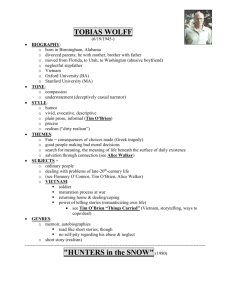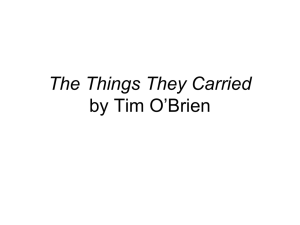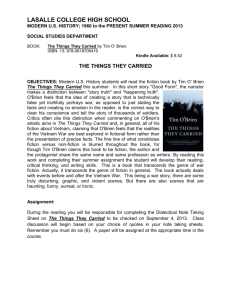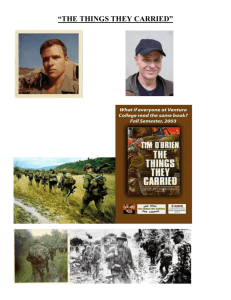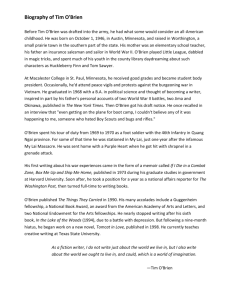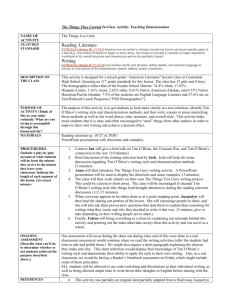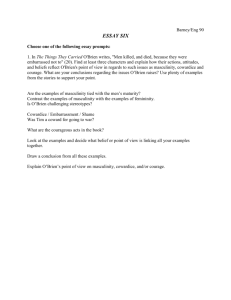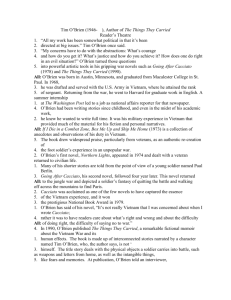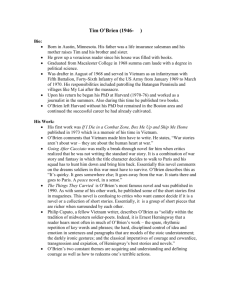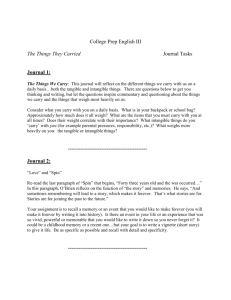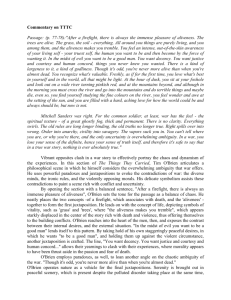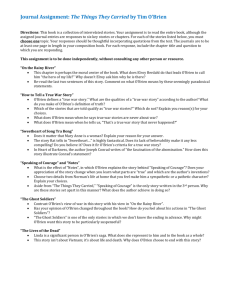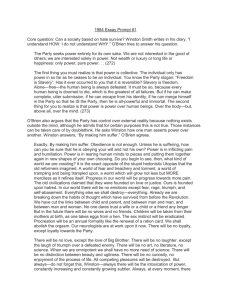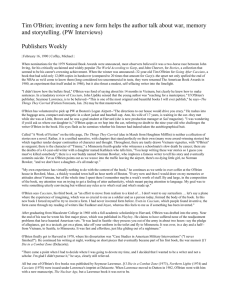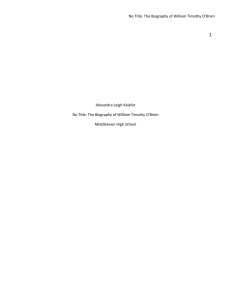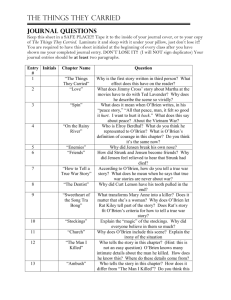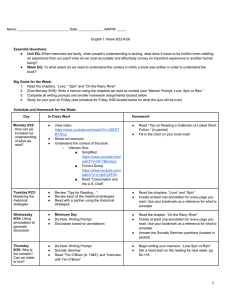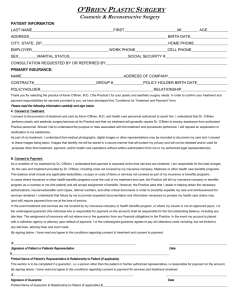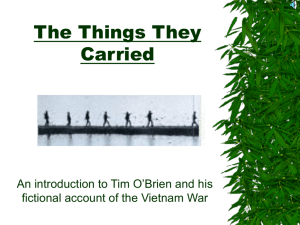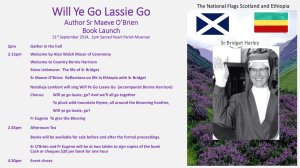"The Things They Carried" Introductory PowerPoint
advertisement
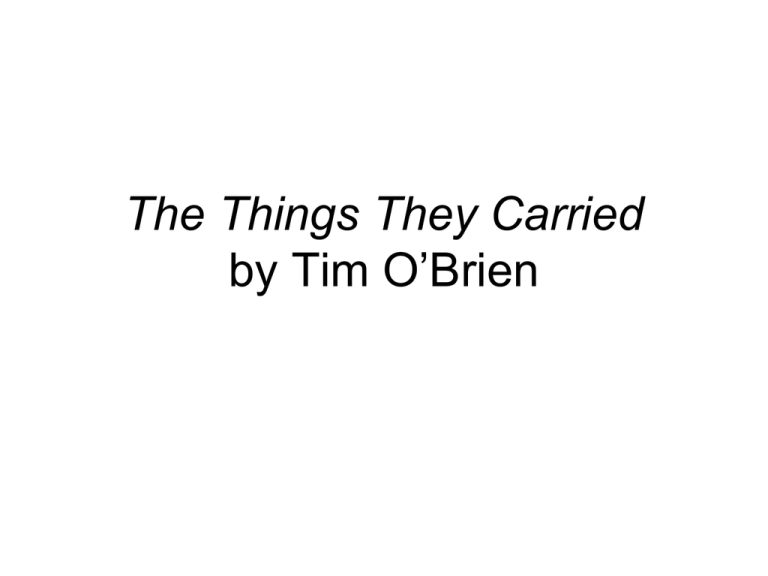
The Things They Carried by Tim O’Brien The Things They Carried • First published in Esquire in 1986, “The Things They Carried” became the lead story in the book Viking published in 1990. • The book received widespread critical acclaim and established Tim O’Brien, the writer, as a major figure in Vietnam literature. Tim O’Brien • Born October 2, 1946 • Raised in small town of Worthington, Minnesota • Attended Macalester College in St. Paul, where he took part in the antiwar movement and participated in war protests and peace vigils • He graduated with a degree in political science and planned to go to graduate school to study government when he was drafted Tim O’Brien • Resisting the impulse to defect to Canada, O’Brien joined the infantry • While he received the Purple Heart for wounds he received, he always despised the war and everything about it Tim O’Brien • After the war, while pursuing graduate studies at Harvard, O’Brien wrote his first book • Since 1973, O’Brien has been a full-time writer • The Things They Carried, the collection of interrelated stories we are about to read, was a finalist for the Pulitzer Prize in 1993 Historical Context – Vietnam War (1955-1975) • • • The major historical context for O’Brien’s book is the war in Vietnam. The war was fought between North Vietnam, and its Communist allies, and the South Vietnamese, supported by the United States and other anti-Communist nations The reasons the U.S. became involved in the complex are complex, but a major impetus was the acceptance of the “domino theory”: the belief that the North Vietnamese would spread Communism throughout Southeast Asia and shift the balance of power during the Cold War. Historical Context – Vietnam War (1955-1975) • Intensive U.S. involvement began in 1965 when President Lyndon Johnson sent U.S. Marines to defend Danang airfield • By the start of 1968, nearly half a million American troops were in Vietnam • Important Milestones: Tet offensive (1968); “Vietnamization” (1969); Mylai Massacre • The war ended in 1975 with the capture of Saigon by the North Vietnamese The War at Home • All young men were required to register for the selective service and face being drafted into the armed forces to serve in Vietnam. While some young men of wealth and privilege escaped the draft by receiving deferments, other objectors who were less fortunate fled to Canada or openly defied the draft and faced criminal charges. The War at Home • The anti-war movement intensified at home from 1968-1970. Protests became more frequent on college campuses, and police presence increased in response to the threat of violence. • Important Milestones: Assassinations of MLK and RFK (1968); Riots at DNC in Chicago; Uproar over Mylai Disaster; Kent State (1970) Plot Summary • The Things They Carried recounts the experiences of Lieutenant Jimmy Cross’s infantry unit before, during, and after the Vietnam War. Thematic Concepts • Love & Shame – How do feelings of love and shame propel the soldiers’ actions? • The Individual and the Collective: How do the soldiers appear as individuals? How do they sacrifice their individual identities to become part of a group? • Truth: In what ways is truth subjective? What is the difference between “story truth” and “happening truth”? • Morality: How can morality exist within the context of war? • Solitude & Isolation: How can solitude and isolation intensify feelings of despair? Literary Elements • Point of View and Narration: In the title story, the narrator is unidentified, but in other stories he is a “fictional character named Tim O’Brien.” • Realism: Method of accurately describing the details, general attitude, and philosophy of ordinary life that favors confronting the realities of life instead of escaping or idealizing them. – Hyper-realism: Lingering over details smaller than an ordinary observer could perceive (Example: the buzz of a mosquito) – Magical realism: Weaving fantastic or imaginary elements into a narrative that otherwise has all the features of an objective realistic account. (Example: the sun sucks a soldier up into a tree) Fact or Fiction? • Questions over the truthfulness of the book linger. • O’Brien’s response in Contemporary Literature: “What I’m saying is that even with that nonfiction-sound element in the story, everything in the story is fiction, beginning to end. To classify different elements of the story as fact or fiction seems to me artificial. Literature should be looked at not for its literal truths but for its emotional qualities. What matters in literature, I think, are the pretty simple things – whether it moves me or not, whether it feels true. The actual literal truth should be superfluous.”
